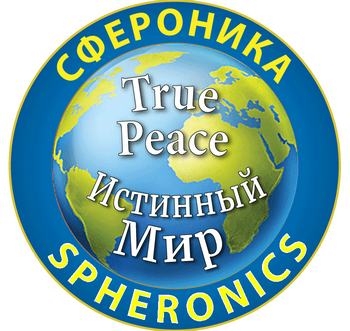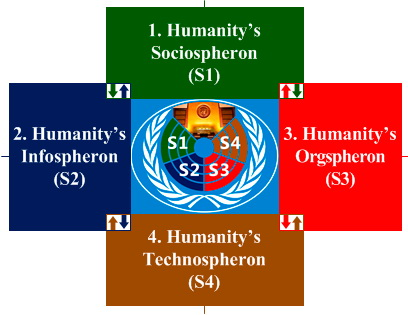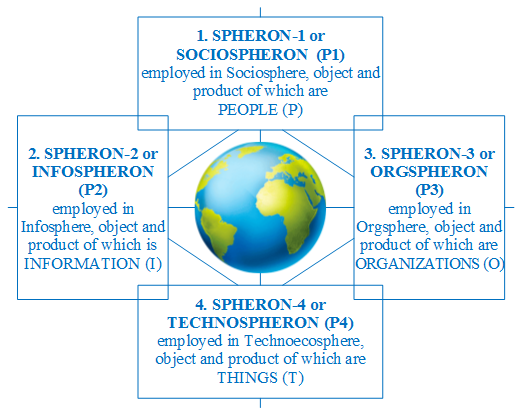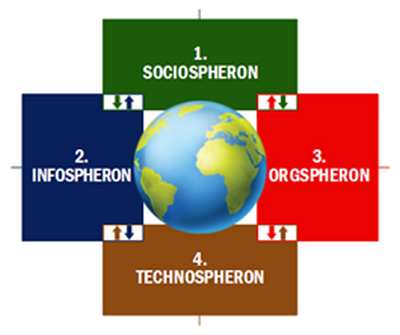
Spheronics: True Peace Megascience Contents: https://peacefromharmony.org/?cat=en_c&key=1129
11. The UN True Peace Spherons as Structural Model Base
of Scientific Global Peacemaking Governance By Leo Semashko, (+coauthors) Publication: English: https://peacefromharmony.org/?cat=en_c&key=1143 Russian: https://www.peacefromharmony.org/?cat=ru_c&key=1044
This paragraph concerns the UN key international body, designed to ensure global peace but in reality, for almost 80 years, it has brought humanity to the very brink of a third, nuclear world war, in 90 seconds away (Mecklin, 2023). It seems that the UN history, created in the same year as the nuclear bombings of Hiroshima/Nagasaki in 1945 with almost 300 thousand victims of innocent civilians were, repeats the League of Nations (1920-1946) fate, which was dissolved for its inability to prevent the WWII. 1. The League of Nations and the UN as Institutions of False Peace The only scientific explanation for the more than a century of anti-war impotence of international peacemaking organizations is that they were organizations not of true but of false peace, that they were created not the peacemaking, friendly but as confrontational, militaristic states. These states are really aiming at endless wars, preparing for them and continuously accelerating the arms race, which they camouflage with hypocritical propaganda statements about striving for peace and security. The false peace definition, both Versailles 1919 and Yalta-Potsdam 1945, which ended two world wars and in which both international organizations (the League of Nations and the UN) were identified, is disclosed in paragraph 1. But in the last century of total peacemaking ignorance, powerless naked pacifism, the true peace science absence and the deep stagnant crisis of the social ideological semi-science, which was “incapable of either explaining the current events or foreseeing their future course” (Sergei Glazyev, 2021), there could not be any other peace but a false one. It was a boon compared to the hot and bloody world wars with tens of millions of victims on the principle of Cicero: "bad [false] peace is better than a good war." However, the true, fair and eternal peace remains best of all, still inaccessible to partial thinking and science as the “divine peace of the pre-established, sociogenetic harmony of spherons” (paragraphs 5 and 6), the unprecedented advantages of which are revealed by the holistic peace science of spheronics and are partially presented in paragraph 9. The traditional disciplinary (broken) thinking and science are powerless in the problem face of holistic, transdisciplinary true peace; therefore this peace has remained inaccessible and unknown to the League of Nations and the UN. Of course, these organizations, with all the scientific and organizational impotence in their main mission - to prevent world wars by establishing true, global peace, were useful in deterring wars and in realizing the exorbitant complexity of integral, true peace and security. Unfortunately, the UN still does not know the scientific difference between false and true peace, which the thinkers of the past spoke about (paragraph?) and contemporaries are increasingly aware of (MacArthur. Satan’s False Peace, 2022, etc.), which is illustrated by the figures below. 
https://www.youtube.com/watch?v=ndKHUBvnbuE Until now, unfortunately, the UN is not able to critically realize this intellectual shortcoming and scientific gap in order to raise a question and organize work on the creation of the true peace science, which was created, in the first approximation, for further development, in the GGHA during 18 years but ignored by the UN all these years. Similar pseudo-peacemaking UN may exist for another century, until the nuclear powers and their war completely destroy humanity. The fundamental alternative to the UN false peace impotence is the GGHA large international project, 2017, "Network Spherons: The UN Harmony Replacing UN Disharmony". It has 82 pages, bibliography of 244 sources, translated into 5 languages, by 21 coauthors from 11 countries with the support of two Nobel Peace Laureates and 173 coauthors from 34 countries of the GGHA book “The Global Peace Science (2016). This project was sent to the UN and UNESCO but was ignored. It is published here: http://www.peacefromharmony.org/?cat=en_c&key=769 In this paragraph of our primer, where the emphasis is not on criticism but on positive constructive alternatives, the main ideas and advantages of the scientific peace project of the substantially renewed UN are briefly presented, which are urgently needed today. This will be the true peace UN spherons as its only global actors; therefore, the spherons UN of will only follow the true peace strategic goal, the highest socio-economic and peacemaking effectiveness of which is disclosed in paragraph 10. Below is presented in general terms only the true peace UB structural framework that is adequate to this strategy on the societal foundation of universal spherons. 2. Scientific foundation and social structure of the true peace UN Historically developed forms and models of national and global governance demonstrate the inability to effectively address growing national and global problems, risks and challenges. It expressed well here: “OUR GLOBAL SYSTEM IS NOT EQUIPPED TO DEAL WITH TODAY’S RISKS. Our current international system – including but not limited to the United Nations – was set up in another era, following the Second World War. It is no longer fit for purpose to deal with 21st century risks ... We urgently need fresh new thinking in order to address the scale and gravity of today’s global challenges, which have outgrown the present system’s ability to handle them” [70. Szombatfalvy, 2016]. At the present stage of international relations and their governance, humanity has stopped before two global obstacles: before its deep systemic harmony and before the lack of its scientific and holistic rational comprehension, which is understandable to all reasonable people and institutions. Based on the formulated fundamental prerequisites, it is proposed here to manage international cooperation in the paradigm of true peace, the United Nations Harmony (UNH) based on the fundamental scientific transformation of the traditional UN. For the UNH, the “Model of Spherons Global Governance” (MSGG) is proposed, in which Spherons - harmonious classes/communities of humanity constitute the key object and subject / actor of global harmony and its management. They are disclosed in the previous paragraphs (4, 5, 6, 7). The democratic decision-making procedures at the MSGG UNH are based on dialogue and spheral consensus. Spheral consensus is the unanimity of the spheral actors of governance by the majority of votes in each of them. There can be no confrontation between the spheral actors of governance and the opposition on the issue of harmony as a single goal and strategy, but they are permissible and possible within these actors, between their different parts on ways and means of their implementation. This excludes antagonism between them and the suppression of any spheral actor, but leaves room for internal system opposition in resolving differences between their parts through the widest possible dialogue. The mechanism of built-in systemic opposition prevents any possibility of dictatorship and usurpation of power by any party and any official in the system of spheral democracy of UNH. Laszlo Szombatfalvy, Swedish businessman of Hungarian origin, the Global Challenges Foundation founder in a result of his vast practical governing experience for more than 60 years, came to the following exact conclusions regarding the world need for a fundamentally new model of global governance: 1.Sovereign nation-states are unable to manage the global challenges in a satisfactory way. 2.No national politician is accountable for the good of all humankind. 3.The American electoral system should be reviewed. 4.Even though every nation says it wants to live in peace, we spend nearly five billion dollars every day to defend ourselves against each other. My belated conclusion is that no governance system can guarantee that there will be no future wars – unless we implement global and total disarmament. 5.I can only see one rational solution: We have to find a new, more effective way to cooperate globally. We urgently need to find a new system of governance, which would effectively and fairly manage the major global challenges. 6.I’m convinced that new ideas will continue to hatch as long as humans exist. New and better models can start a much-needed global debate. [157; 158]. In these 6 points, a correct assessment of the absolute inability and insufficiency of traditional global governance is expressed, and on the other hand - a firm awareness of the need for an alternative model. Both requirements are laid in the basis of the global governance model of the true peace UN proposed below. The review of "Global governance models in history" showed the main weaknesses of traditional governance models and some necessary requirements. The main one is that the global governance of humanity must lean "on the basis of what all have in common," which is revealed only by science in the best way. [Jiborn, Magnus (2017) 160] However, scientific awareness of the general social structure of spherons as actors of humanity and its true peace is still missing that no "allow us to make collective decisions at the global level, taking into account the interests of all." [160] We found the most adequate for it the system of legislative procedures proposed by lawyers Grenville Clark and Louis Sohn in 1958 [162 pp. 12-17; 163; 164]. This system, aimed at ensuring global peace and general disarmament is using with some modifications in our model of global governance. It can include some other legal projects of global governance and world democracy.
3. Structuring the UNH MGUS
The UNH MGUS is proposed to start for 4-5 years of testing and verification, as an experimental regime of the functioning for the current UN. Therefore, we will distinguish between two orders and two UN systems: the "Traditional UN" (TUN) and the "Experimental UN" (EUN), identical to the UNH. Both regimes function simultaneously, in parallel, but the experimental regime, within the annual dynamic range of 2-6 months, is included in the regulations of the traditional UN and is subject to it until the end of the experiment, although it must have relative autonomy enshrined in its Charter. Their fundamental difference is that for more than 70 years the TUN has put up with endless disharmony, especially militarism and wars, while the UNH excludes them by the spheron’s harmony in all ways and in all dimensions. The four-spheral structure is recognized as the highest structural law of all UNH governance bodiesin accordance with the genetic socionome of humanity in statics and dynamics (paragraphs 5 and 6), which ensures the equality of interests of each of the four spherons of humanity. The equality of spherons expands to the equality of the UN member states and gender equality, regardless of their number. The three named managerial equalities (spheres/Spherons, nation-states and genders) are integrated by the fourth, defining one - "Spheral Harmonious Democracy" (SHD), based on an equal distribution of power between the spherons and their genders. Thus, four fundamental harmonic regulators of the UNH are formed, united in the integral mechanism of the SHD of our model. In the UN Charter the “Spheral General Assembly” (SGA) of 196 member states of the UN is recognized as the highest legislative body. The number of which, taking into account their dynamics, is equal to 200 with the representation of each sphere of each state by one “spheral emissary” employed in the corresponding sphere, with a mandate for 3-4 years with equal gender representation of the spheres. The Spheral emissaries are appointed by the highest legislative body of the UN each member-state. (Then they can be elected by the population of each country). As a result, the UNH SGA is formed with 800 emissaries with equal representation of the interests of each state, each of its production spheres, each of its spherons and each of its gender, regardless of their number and its dynamics. It is possible to expand the UNH SGA by 2 times (1600 emissaries) if the need for equal gender representation of each sphere is recognized, i.e. 2 emissaries (female+male) from each sphere of each member-state. This option is more harmonious, fair and preferable, although it is more costly. The spheral structure of the UNH legislative body with equal representation of four spherons in it from each of its member states is expressed by the corresponding model below. The UNH True Peace Spherons The GHA Project 2017

Mosel-10 The UNH social foundation of the four-sphere structure is the objective social structure of humanity of the four constant spherons, which change only in terms of numbers and qualitative professional composition. We know the total population today: “7 billion as of October 31, 2011. If the dynamics of population growth does not undergo dramatic changes, then the threshold of 8 billion people will be overcome approximately in 2024 and 9 billion in 2042” [171]. The generalized representation of the spherons of humanity is expressed by the following model. Model-11 (2017). Humanity SPHERONS

Updated model-12. Humanity Spherons

To date, there are no statistics of Spherons. Therefore, the number of each Spheron of humanity today can be hypothetically determined by the model of their statistical proportion found for an average country of any past year. Such calculations are presented in detail in Chapter 2 of Global Peace Sciences [78]. It is obvious that such an extrapolation of the proportions of one country to all humanity is rough and approximate, but another does not exist today. The proportions of the number of spherons in each country and each region are very different. Their determination requires appropriate statistical studies according to the approved methodology used. This is a very time-consuming scientific statistical work for all countries, available only to the UNH. The project considers different interpretations of the four spherons of humanity: thermodynamic, sociocybernetic, demographic, statistical, mathematical, technological, democratic (political), disarmament, educational, religious, environmental, economic, welfare and others, which are excluded from the paragraph to avoid duplication. The main meaning of the UN project of true peace and its implementation is that it provides humanity with a scientific, constructive and nonviolent transition from the past history of wars, violence, militarism and growing risks of survival to a new history of universal peace, prosperity of all peoples and harmonious sustainable development in nature. for future generations. The True Peace UNH will transform the false peace one-sided political structure of the traditional UN militarized states into a harmonious, four-spheral structure of the true peace continuous production in all countries based on four innovative technologies of the business and government formats. These technologies of true peace are: GlobStat, Strong Artificial Intelligence, Fractal Organization of Social Production Governance and Spheral Harmonious Democracy of true peace. This updated, true peace UN roadmap will be revealed in more detail in subsequent paragraphs in addition to the previous ones. References in total: 244 sources. Bibliography, selectively: Leo Semashko 15-07-23 ----------------------------------------- ------------------------------------- Dialogue: Pro and Contra --------------------------------------------
Up
|